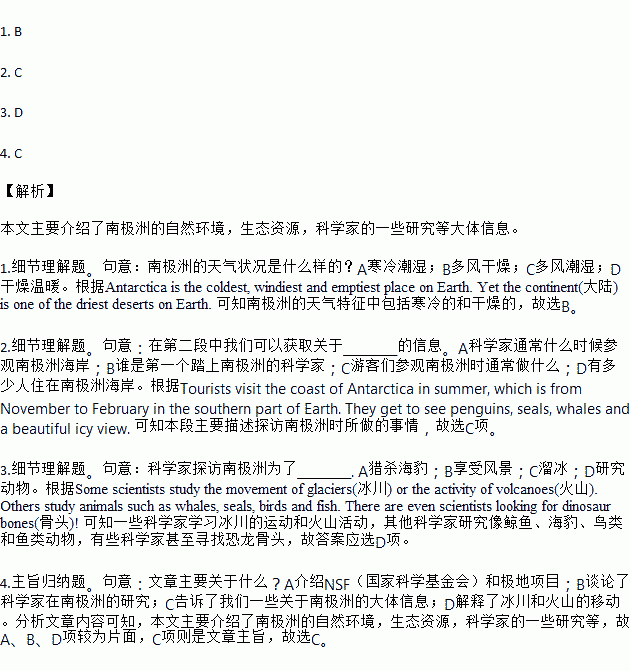题目内容
Antarctica is the coldest, windiest and emptiest place on Earth. It is home to penguins and different sea life. The cold weather over millions of years has created a huge layer(层) of ice that covers Antarctica. In some places, the ice is about 20 meters thick. Yet the continent(大陆) is one of the driest deserts on Earth.
Humans have explored the area for years. The first human to set foot on land in Antarctica is said to be John Davis, a US seal(海豹) hunter, in 1821. Tourists visit the coast of Antarctica in summer, which is from November to February in the southern part of Earth. They get to see penguins, seals, whales and a beautiful icy view.
But who lives and works in Antarctica? They are mostly scientists and those who help them carry out their research.
The National Science Foundation(NSF) is a US organization. Polar Programs, part of the NSF, supports scientists in both the Arctic and the Antarctic.
“Each year, we send more than 100 teams of scientists to our three research stations in Antarctica,” Polar Programs' spokesman Peter West said.
Some scientists study the movement of glaciers(冰川) or the activity of volcanoes(火山). Others study animals such as whales, seals, birds and fish. There are even scientists looking for dinosaur bones(骨头)!
1.What's the weather like in Antarctica?
A. Cold and wet. B. Windy and dry.
C. Windy and wet. D. Dry and warm.
2.In Paragraph 2 we can get the information about ________.
A. when scientists usually visit the coast of Antarctica
B. who was the first scientist to set foot in Antarctica
C. what visitors usually do when they visit Antarctica
D. how many people live on the coast of Antarctica
3.Scientists visit Antarctica to ________.
A. hunt seals B. enjoy the view
C. ice skate D. study animals
4.What is the passage mainly about?
A. It introduces the NSF, and Polar Programs.
B. It talks about the scientists' study in Antarctica.
C. It tells us some general information about Antarctica.
D. It explains the movement of glaciers and volcanoes.

